How the exhaust hood with recirculation works + typical ventilation schemes with air recirculation
Whereas when using a flow hood, dirty air leaves the room through the duct, a hood with recirculation has a completely different principle of operation.
Here, such an element as an air duct is absent, and the device itself is equipped with efficient filter traps. When passing through them, the air is freed from all harmful micro-impurities and undesirable odors, and then it is again fed into the room.
In this material we will talk about the principles of operation of such equipment, denote the subtleties of the choice and scheme of the arrangement of ventilation.
The content of the article:
How does a recirculation hood work?
The recirculation hood operates in a closed cycle. In fact, it can only be called an exhaust device conditionally, since it does not remove air from the room, but only cleans it and returns it back.
Contaminated air enters the device’s body under the influence of traction created by the fan blades, which rotates in a plane horizontal to the surface of the stove.
Moving along a predetermined path, the air mass collides with a coarse filter. After passing through it, it leaves fat inclusions, particles of soot and dust on its fine-mesh surface.
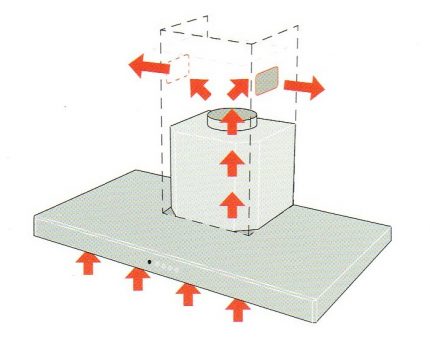
Further, the air flow under the influence of pressure passes through a fine filter, where it gets rid of odors and residues of the smallest parts, then returns to the room.
This filter is an ordinary cartridge, the filler of which is granular carbon. The carbon filter is a disposable product, therefore, as it becomes dirty, it must be replaced.
Since this type of hood does not interact with the ventilation system, designers developed telescopic hoods. During operation, they create powerful lateral traction, due to which all dirty air masses are sucked.
As soon as the need for this disappears, the device hides in the countertop. This solution is not only original, but also very convenient.
Positive and negative points
Despite the fact that the filter hoods have low productivity, they have many advantages.
These include:
- simplicity of installation and operation;
- unlimited choice of plate placement, as a ventilation shaft is not needed for this;
- easy care.
Cons of these exhaust devices are also available. This is a small efficiency - up to 70%, the need for frequent replacement of disposable filters - 3-4 times in 24 months. The hood does not affect the humidity level in the room. The device’s electric drive when it is turned on creates a certain noise.
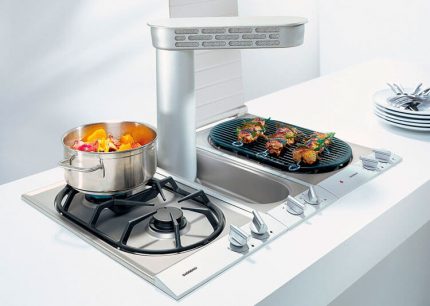
Hoods of the latest releases, as a rule, can work both in the mode of removing air masses and as recirculation ones. Such a device must have connection to the ventilation shaft.
Since the autonomous hood does not provide fresh air, ventilation must be ventilated after it is turned off.
Types of autonomous hoods
Depending on the mounting system, recirculated hoods are flat, mounted above the stove and having low productivity. Exist and built-in range hoodand integrable in furniture elements placed above the hob. They are compact and have more performance than the first.
Hanging hoods are placed under the kitchen cabinets. In this category there are slider options with a sliding forward working surface. At a certain angle to the mounting surface have angular hoods.
They are ergonomic, easy to operate, high performance, have a low noise level.
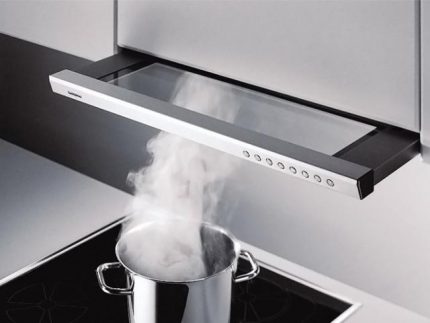
At the installation site, the hoods are divided into wall, corner, island. The first are used to complete the zones located near the wall, the second - at the junction of the walls. Island - ideal for spacious kitchens.
Features of the choice of hoods
Basically, the hood is selected according to parameters such as depth and width. They are determined by the dimensions of the hob. Ideally, the unit should be wider than the plate a few centimeters. This positively affects the efficiency of the intake of exhaust air mass.
Different models of autonomous hoods differ in a set of functions. The more of them, the more expensive the equipment. Manufacturers equip them with electronic panels with displays for more convenient control and monitoring of the device. Sometimes there are programmable timers, sensors that automatically turn on the fan when humidity and temperature indicators change.
Special sensors can independently adjust the performance of the hood. The presence of the remote control in the kit allows you to start and turn off the unit without direct contact. When choosing, you need to strive to ensure that the model's functionality meets the specific requirements as much as possible. Paying for unclaimed features is irrational.
Recirculation filters
So much quality air recirculation will occur, depending on the number of filters in it. Hood models of the latest releases are equipped with two types of filters. The first, made of metal (aluminum or stainless steel), is called fat.
Its purpose is rough cleaning. As a necessary minimum, it is always included in the unit kit. Without it, any engine simply could not function.
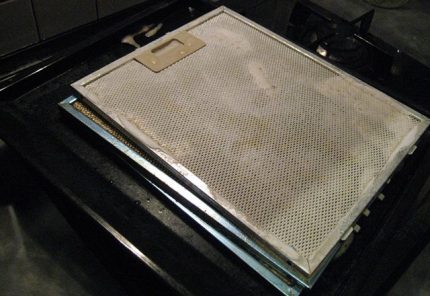
A grease filter made of metal resembles a cartridge. It includes a metal frame and the filter itself. Perforation of the filter element is asymmetric and symmetrical.
Care for it consists in periodic cleaning using household chemicals. Fix it outside the cleaning device. It can be either disposable or reusable. Efficiency depends on the shape and size of the mesh cells.
Read more about grease filters in this stuff.
A second filter is followed by fat - coal. It cleans the air passing through the first filter, depriving it of odors. These filters are not cleaned; when clogged, they are simply replaced with new ones. The fact that the time has come to change the filters of the second type is notified by special sensors. Manufacturers are sure to equip them with their new models.
Additional filters that provide finer cleaning are:
- Acrylic designed for reusable use. They have a very delicate structure, so you need to wash them by hand and in no case wring them, otherwise the fibers will change their original position.
- In the form of disposable inserts - syntepon, paper or non-woven. When the drawing on them is not visible due to the layer of dirt, they are replaced with new ones.
- Coal endowed with an absorbent property. They are much denser than the first two, they retain good odors.
The first three are used in economy class hoods, called flat hoods. Visually, these filters resemble a lightweight rug. Although some housewives wash them and then reuse them, this procedure does not return the synthetic material to its original properties. The quality of air purification is then reduced.
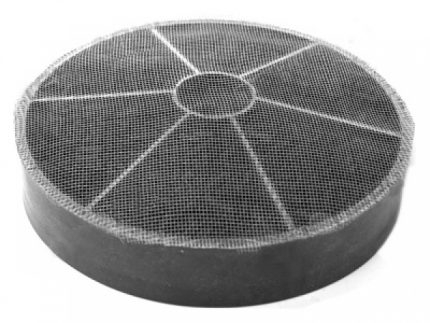
The density of carbon filters is different. As it fills, air passes through it more slowly, so it is necessary to change the cartridges in a timely manner. Usually they are not included in the hood.
To extend the duration of the use of carbon filters, you must leave it on for another five minutes after using the hood. This short time is sufficient to allow moisture to escape from the filter, which contributes to caking of the coal and lowering its adsorption capacity.
The frequency of replacement of fine filter cartridges depends on how intensively the equipment is used. Typically, the instructions that manufacturers attach to the product specify the frequency of such a replacement.
When choosing filters for your recirculation hood, be sure to check the parameters of the slots for the cartridge. If the sizes do not match, they either cannot be inserted correctly, or gaps form, which is unacceptable.
If the hood is used from time to time, universal filters can be used. They are made of polyester and impregnated with activated carbon. The fabric is capable of absorbing both grease and odors.
How to replace the charcoal filter?
If the carbon filter has expired, replace it. To do this, the exhaust device is disconnected from the electrical network, otherwise the electric motor may accidentally turn on spontaneously.
Next, they remove the grease filters and take out the cassette from the casing with the dead coal filter.
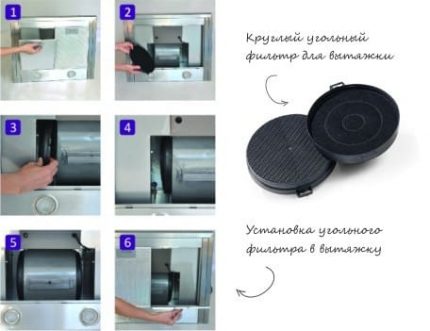
A new filter is inserted into the cartridge, then the latter is closed and placed in an appropriate place on the hood.A correctly executed operation is indicated by a characteristic click. After that, the coarse filter is returned to the place, connect the device to the mains and check its performance.
As a rule, the manufacturer applies instructions for installing them to carbon filters. If the case of the coal element is designed so that it can be opened, this means that it is possible to replace its contents - replacing the used granules with new ones.
Grease filter rinse
In order to rinse the grease filter, it is removed from the device. The pelvis is filled with water, the agent used to remove fat is added. After they take a stiff brush and perform cleaning from fat deposits and soot.
If this method was ineffective, soak the filter in a solution consisting of laundry soap and soda for about 3 hours. After soaking, the filter is cleaned, dried and put in place.
Best Filter Samples
Grease filters are made by many manufacturers. Among the best is the Russian company Lissant-Yug. Non-separable cassettes from stainless steel or galvanized steel are produced here. The filter of five plates withstands temperatures up to 70⁰.
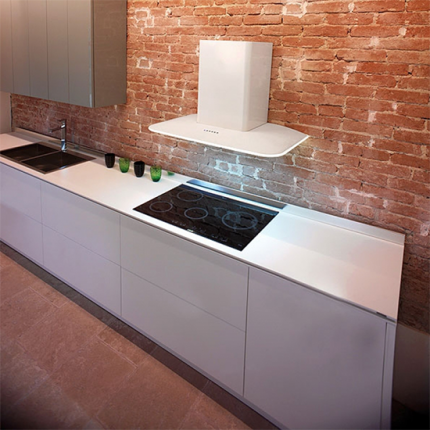
Stainless steel filters are produced by the company "Titan". The temperature of the working environment for them is 70 ⁰С. Product thickness - 0.5 mm. Up to 80 ⁰С - the maximum temperature for filters made of galvanized material or stainless steel, manufactured by the manufacturer "Roven".
An element includes three to five plates. The best examples of carbon filters include elements manufactured by such well-known manufacturers as Electrolux, Gorenje, Folter, Hansa, Krona.
Recirculation ventilation
The very concept of ventilation with air recirculation means that the process is carried out with the return of all or part of the air removed from the room with the possible mixing of air from the outside. In what ratio the air masses are mixed determines the design decision taking into account specific circumstances.
Recirculation ventilation scheme
Supply and exhaust ventilation with recirculation works according to a certain scheme. Air from the street enters the room through the mine. After some time, the hood draws it. Part of this air mass is thrown out, and the remainder goes into the mixing chamber, where it mixes with the new influx.
Depending on how the system is configured, the air entering the chamber is heated or cooled. His further path is an air conditioner or air heater and return to the room.
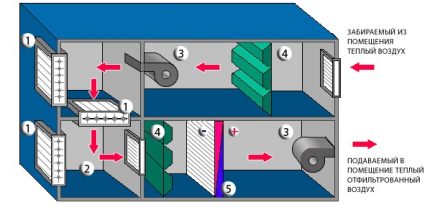
Recirculation significantly reduces the load on systems designed to handle air masses.
Air will always have indicators that make it suitable for breathing if two main conditions are met:
- The minimum volume of air coming from the street is 10% of the volume processed by the supply unit per unit time.
- In the air mass entering the room is 30% of the permissible concentration of harmful impurities as a maximum.
With the participation of recirculation, the system operates with a constant flow of thermal energy, as well as a constant speed of transported air flows, regardless of the time of year. This fact is the guarantee that the air entering the room will be evenly distributed throughout the volume.
Scheme implementation options
There are different options for implementing ventilation schemes with recirculation. This is recirculation by a fan installed under the ceiling of the room, and through the ceiling channel, and through the central air handling unit. The air exchange in the first way can only conditionally be called recirculation.
There is no heat exchanger, and if you connect it to the fan and separate them into a separate unit, you get a fan coil or fan coil. In the heat exchanger, in this case, the recirculated air is cooled or heated. Outside air flows separately and has its own individual parameters.
Removal of harmful substances occurs only through the outside air. In ventilation systems fan coils not often used, as they do not ventilate the room, but only affect the internal temperature.

When recycling according to the second option, through the ceiling channel, the length of the ducts is insignificant. Sometimes a heat exchanger and a fan are placed in the channel up. This is the standard scheme for air conditioners having a duct indoor unit and used in rooms with medium and small volume.
If in the main air handling unit with recirculation to the air heater close the valve that lets in air from the outside, you get complete recirculation. The ventilation system in this case is used as air heating. Blocks inside split air conditioners and fan coils often have a design that makes it possible to mix street air.
In this case, the air flow with the required temperature enters the room through one air distributor. Air conditioning units are designed according to this principle. For large rooms, this scheme is not suitable, because there is little power, there is no mixing chamber, automation and there is no heat recovery.
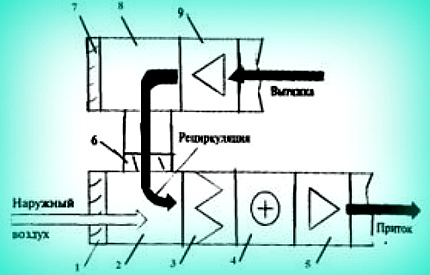
Ventilation of large enough rooms is carried out with the use of large-scale central installations, including a large set of equipment. The recirculation scheme used in this case provides economical operation through flexible control of the system. Maintaining the desired ratio of the amount of external and exhaust air is carried out by means of valves.
With the recirculation valve closed and the exhaust and flow recirculation open, no. If you close the last two valves and open the first, complete recirculation is observed.
Cons of ventilation with recirculation
The use of air recirculation limits SNiP 41-01-2003. He does not allow it to be used from rooms where substances of 1-2 hazard classes are released and the consumption of street air is regulated by their mass.
You can not use recirculation and where in the air the concentration of fungi and bacteria exceeds the norm or there are clearly expressed unpleasant odors. Laboratory rooms where they work with flammable or hazardous gases are not suitable for recycling.
Conclusions and useful video on the topic
Video about a flat cooker hood:
About installing a charcoal filter in a cooker hood:
Hoods working on air recirculation allow not to connect them to the ventilation shaft. Using integrated filters, they effectively clean the exhaust air. At the same time, it is necessary to replenish fresh air in the room through the vents.
Perhaps you have experience using recycle hoods? Tell us which device you are using and are you satisfied with its work? Please leave your comments at the bottom of the article.

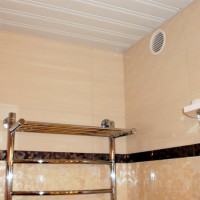 What to do if the hood in the bathroom and toilet works poorly: causes of the problem and methods for solving it
What to do if the hood in the bathroom and toilet works poorly: causes of the problem and methods for solving it 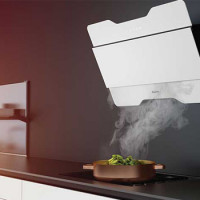 Coal hood: types, device, selection and installation rules
Coal hood: types, device, selection and installation rules 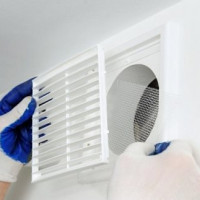 What to do if the ventilation in the apartment and the house does not work? Overview of possible causes and solutions
What to do if the ventilation in the apartment and the house does not work? Overview of possible causes and solutions  Sandwich pipe for ventilation: installation instructions and the nuances of assembling ventilation from a sandwich pipe
Sandwich pipe for ventilation: installation instructions and the nuances of assembling ventilation from a sandwich pipe 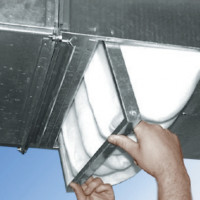 Replacing the filter in the supply ventilation: selection features + filter replacement instructions
Replacing the filter in the supply ventilation: selection features + filter replacement instructions 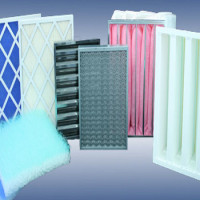 Filters for ventilation: types, features and disadvantages of each type + how to choose the best
Filters for ventilation: types, features and disadvantages of each type + how to choose the best  How much does it cost to connect gas to a private house: the price of organizing gas supply
How much does it cost to connect gas to a private house: the price of organizing gas supply  The best washing machines with dryer: model rating and customer tips
The best washing machines with dryer: model rating and customer tips  What is the color temperature of light and the nuances of choosing the temperature of the lamps to suit your needs
What is the color temperature of light and the nuances of choosing the temperature of the lamps to suit your needs  Replacement of a geyser in an apartment: replacement paperwork + basic norms and requirements
Replacement of a geyser in an apartment: replacement paperwork + basic norms and requirements
We have such a hood at home. The seller in the store praised very much, we bought it. In principle, not bad, but for those who often cook a lot, it will not work, too often you have to change filters. Although it is stated that once every six months, I have a maximum of 3 months. Maybe try to set other filters, non-native? The main thing is that they fit in size. Who puts what in such hoods?
You should clarify which hood you have, the material lists models with different filters. If we are talking about coal, then according to the instructions, they just work for 3 months.
Good day, Elena.
Carefully study the hood data sheet - you may find a section on filter interchangeability. Another option is to go to the store, grabbing the filter. The seller may offer replacement options.
Carbon filters of the FTR line are popular on the Internet, which, according to the manufacturer, can be adapted to any hood.
There is a desire to put a hood in the kitchen. What is generally worth taking for an apartment? I would like it to work silently, but at the same time it had sufficient retraction power. Well, it didn’t look so ugly. Although modern hoods all look about the same. I know that Bosh produces good hoods, but the price is decent, I would like something cheaper.
Yes, at Bosch the price “bites”. Siemens is also good, they are cheaper, but not by much. If you really want a budget, then look towards KRONAsteel and Elikor.
Good afternoon, Olga.
Take a flowing one, if the ventilation duct allows - no need to systematically change the charcoal filter. The latest models are worth taking - the technique is constantly being improved.
Among the TOP-hoods, experts mention Electrolux products (noise level 50 dB), the cost reaches $ 8500. Low noise have recirculation hoods. For example, German Krona models generate 36 dB and the cost is only ₽3500.